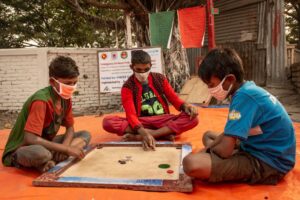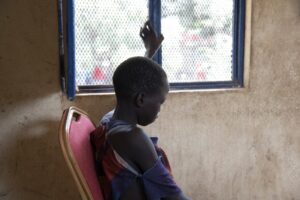On My Mind: Promoting, protecting and caring for children’s mental health.

Highlights
The COVID-19 pandemic has raised concerns about the mental health of a generation of children. But the pandemic may represent the tip of a mental health iceberg – an iceberg we have ignored for far too long. The State of the World’s Children 2021 examines child, adolescent and caregiver mental health. It focuses on risks and protective factors at critical moments in the life course and delves into the social determinants that shape mental health and well-being.
It calls for commitment, communication and action as part of a comprehensive approach to promote good mental health for every child, protect vulnerable children and care for children facing the greatest challenges.
Click here for an interactive view of data from the report.
For parents
Click here for tips and resources on how to talk to your child about mental health.
For young people
Click here for tips on reaching out, providing support and breaking the stigma around mental health.
Please contact: pubdoc@unicef.org
Download
In nearly every part of the world, be it rich or poor countries, mental health conditions – and the lack of caring responses – cause significant suffering for children and young people and are a top cause of death, disease and disability, especially for older adolescents.
An estimated 13 per cent of adolescents aged 10–19 is estimated to live with a diagnosed mental disorder.
Uncertainty. Loneliness. Grief.
These powerful emotions have enveloped the lives of many millions of children, young people and families. Children and young people could feel the impact of COVID-19 on their mental health and well-being for many years to come.
As we enter the third year of the pandemic, the disruption to routines, education, recreation, as well as concern for family income and health, is leaving many young people feeling afraid, angry and concerned for their future.
“Even if you are ambitious, you will not be able to achieve your ambitions because you are psychologically totally defeated.”
– An adolescent girl in Egypt
Even before the pandemic, psychosocial distress and poor mental health afflicted far too many children. In 21 countries, roughly 1 in 5 young people aged 15-24 said they often feel depressed or have little interest in doing things, according to a UNICEF and Gallup global survey, part of the forthcoming Changing Childhood project. Those most at risk include the millions who are forced from their homes, scarred by conflict and serious adversity, and deprived of access to schooling, protection and support.
“When I think about everyone that has died because of the disease it makes me sad, and when I learn the number of cases is increasing, it makes me stressed.”
– An adolescent boy in the Democratic Republic of the Congo
If the pandemic has taught us anything, it is that children’s and adolescents’ mental health is profoundly affected by their surroundings and circumstances – their experiences with parents and caregivers, their friendships and how they play, learn and grow.
Go in depth with UNICEF’s report, Life in Lockdown: Child and adolescent mental health and well-being in the time of COVID-19
The high cost of low investment
Despite all this, governments and societies are investing far too little in promoting, protecting and caring for the mental health of children, young people and their caregivers.
We pay a high economic price for this neglect – around US$387.2 billion worth of lost human potential that could go towards national economies each year. The cost in terms of how it affects real lives, however, is incalculable.
Suicide is the fourth leading cause of death among 15- to 19-year-olds. Every year, almost 46,000 children between the ages of 10 and 19 end their own lives – about 1 every 11 minutes.
Globally about 2 per cent of government health budgets are allocated to mental health spending, less than US$1 per person in some of the poorest countries. These figures fall far short of treating mental health conditions, especially of those facing the greatest mental health challenges, and promoting positive mental health.
Unheard calls for help
Young mental health advocates have not been standing by in silence. Many have been bravely calling for mental health to be addressed in different contexts around the world. In the State of the World’s Children 2021, some have spoken out about their lived experiences with mental health and well-being, the challenges their friends and peers face, and the need for children and adolescents to be able to reach out to get help.
“I was being bullied by my friends … Once I felt hurt and I got disappointed, it really made me feel indifferent towards them.”
– An adolescent girl in Indonesia
They are not alone. The UNICEF and Gallup survey shows that a majority of people in most countries believe that no one should have to deal with mental health challenges on their own and that the best solution is to share experiences and seek support.
And yet, for many millions around the world, there is no one to talk to, nowhere to turn for help.
Understanding mental health: Breaking barriers
Our inability to address mental health can be measured by how little societies are willing to talk about or understand it. The fear of harsh words, laughter and abuse that underline the stigma around mental health make it harder for children, adolescents and caregivers to express their feelings.
“With stress and mental illness, for many it’s a very anxious subject. And you don’t really want to talk about it.”
– An adolescent girl in Sweden
High on a long list of misgivings around mental health is the failure to understand that – just like physical health – mental health is positive. Instead of focusing on conditions to be diagnosed and medicated, mental health needs to be understood as a continuum – at any stage of our lives, we may experience varying degrees of it. We may enjoy life but also have periods of distress. And some may suffer long-term and disabling mental health conditions.

There are, however, common and universal aspects to the experience of mental health: As the 2018 Lancet Commission on global mental health and sustainable development noted, “emotional pain is as fundamental to human experience as physical pain.”
Stories from around the world
It’s time for leadership
UNICEF calls for commitment, communication and action to promote good mental health for every child, protect vulnerable children and care for children facing the greatest challenges.
Commitment means strengthening leadership to set the sights of a diverse range of partners and stakeholders on clear goals and ensuring investment in solutions and people across a range of sectors.
Communication means breaking the silence surrounding mental health, addressing stigmas, improving mental health literacy, and ensuring children, young people and people with lived experience have a voice.
Action means working to minimize risk factors and maximize protective factors for mental health in key areas of children’s lives, as well as investment and workforce development to:
- Support families, parents and caregivers
- Ensure schools support mental health
- Strengthen and equip multiple systems and workforces to meet complex challenges
- Improve data, research and evidence
What UNICEF is doing
UNICEF works to help safeguard the mental health and psychosocial wellbeing of children, adolescents, parents and caregivers in some of the world’s most challenging settings. We have also worked to address the global impact of the pandemic on mental health.
In 2020, we reached 47.2 million children, adolescents and caregivers with community-based mental health and psychosocial support, including targeted community awareness campaigns in 116 countries –almost twice as many countries as in 2019.
The scope of our work in mental health will only grow in the coming years, as will our efforts to secure investment for mental health and to tackle neglect, abuse and childhood trauma that undermine the mental health of too many children.






